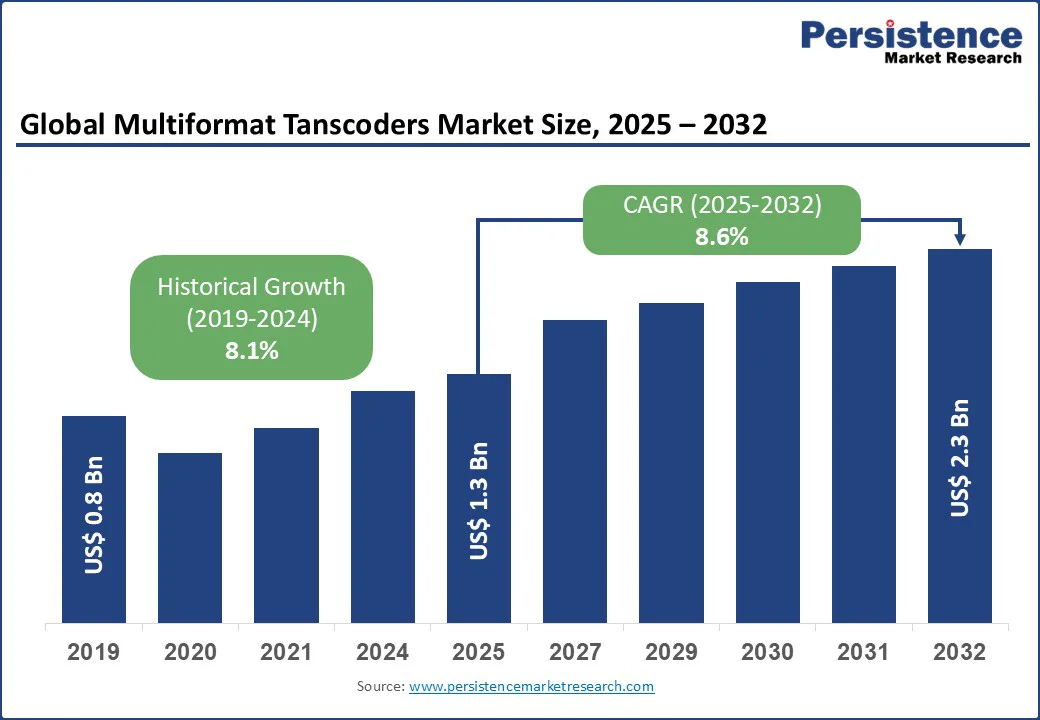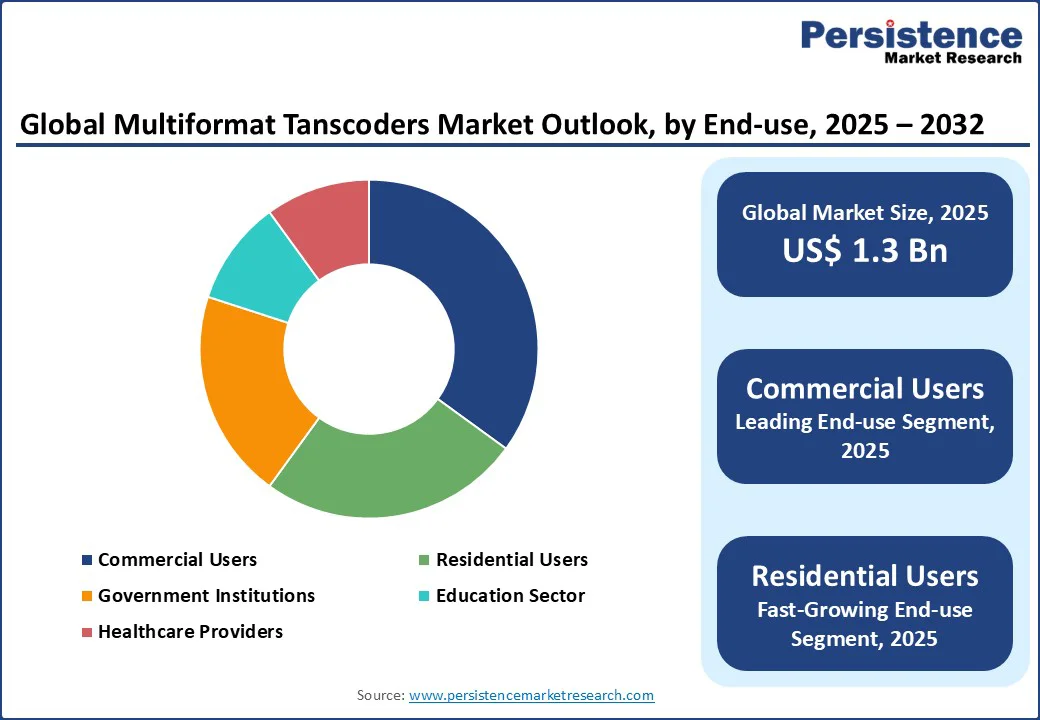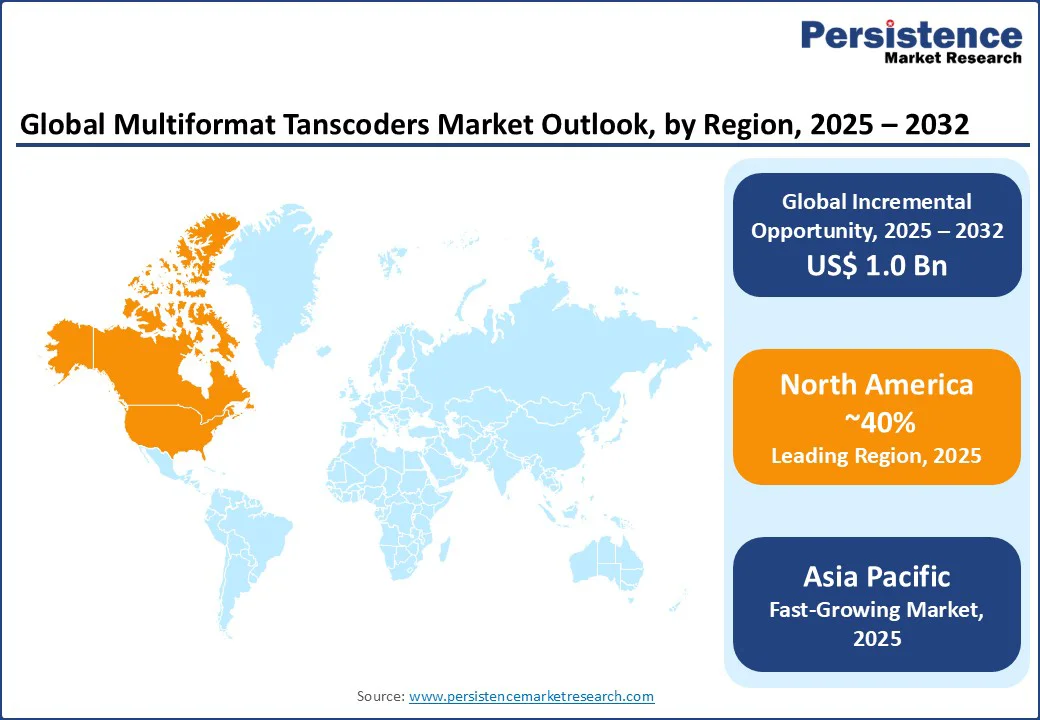ID: PMRREP10873| 186 Pages | 22 Sep 2025 | Format: PDF, Excel, PPT* | IT and Telecommunication

The global multiformat transcoders market size is likely to be valued at US$ 1.3 Bn in 2025, projected to reach US$ 2.3 Bn by 2032, registering a robust CAGR of 8.6% during the forecast period from 2025 to 2032, driven by the rising demand for high-quality video streaming, advancements in cloud-based transcoding technologies, and the proliferation of digital content across broadcasting, telecommunications, and IT sectors.
Key Industry Highlights:

| Key Insights | Details |
|---|---|
| Multiformat Transcoders Market Size (2025E) | US$ 1.3 Bn |
| Market Value Forecast (2032F) | US$ 2.3 Bn |
| Projected Growth (CAGR 2025 to 2032) | 8.6% |
| Historical Market Growth (CAGR 2019 to 2024) | 8.1% |
The multiformat transcoders market is propelled by the explosive growth in digital content consumption, particularly the shift toward seamless video delivery across diverse platforms and devices.
For instance, major streaming services such as Netflix and YouTube continuously adapt their content libraries to fit varying screen sizes and connection speeds, relying on transcoders to convert high-definition videos into formats optimized for mobile devices or slower networks, ensuring that viewers experience uninterrupted playback without buffering issues.
The demand for universal compatibility fosters innovation in transcoding technologies, as content creators and distributors seek tools that can handle multiple formats effortlessly, from raw footage to polished streams.
The evolution of cloud computing infrastructures enables on-demand processing of media files. Companies such as Amazon Web Services and Google Cloud utilize transcoders integrated into their platforms to automatically adjust video quality based on user preferences, allowing global enterprises to manage massive libraries of user-generated content without the need for extensive on-premise hardware.
This cloud-centric approach not only streamlines workflows for broadcasters but also empowers smaller content producers to compete by democratizing access to professional-grade tools.
Despite its promising trajectory, the multiformat transcoders market encounters significant hurdles related to the substantial upfront investments required for deployment, which can intimidate smaller organizations or startups.
For example, a regional broadcasting network might hesitate to adopt cutting-edge transcoding hardware due to the need for specialized servers and software licenses, preferring outdated systems that, while less efficient, avoid the financial strain and potential downtime during migration, ultimately slowing the pace of technological upgrades in niche markets.
Integration complexities with existing legacy systems pose another barrier, often leading to prolonged setup times and operational disruptions.
In the telecommunications sector, for instance, an established cable provider attempting to incorporate networked transcoders into its aging infrastructure might face compatibility issues with proprietary protocols, resulting in fragmented workflows where some channels stream flawlessly while others suffer from artifacts or delays, discouraging widespread adoption until comprehensive retrofitting solutions emerge.
The burgeoning ecosystem of Internet of Things (IoT) devices presents a fertile ground for transcoder innovation, particularly in smart home and connected environments.
Home automation leaders like Philips Hue or Nest integrate transcoders to synchronize video feeds from security cameras with voice assistants, enabling users to receive tailored clips on their smart displays-such as a doorstep visitor alert converted from a wide-angle feed to a focused portrait mode-thus enhancing everyday convenience and opening new revenue streams through bundled services.
Advancements in artificial intelligence offer transformative potential by automating and refining transcoding processes for superior outcomes.
Media companies such as Adobe leverage AI-enhanced transcoders in tools such as Premiere Pro to intelligently upscale low-resolution archival footage for modern platforms, automatically detecting and correcting color inconsistencies or frame rates, which not only saves production time but also revives classic content for contemporary audiences in ways that manual adjustments could never achieve.
Integrated auto-switchers dominate the multiformat transcoders market, expected to account for approximately 45% share in 2025. Their dominance stems from their ability to seamlessly integrate with cloud-based platforms and support multiple formats, making them ideal for broadcasting and IT applications. These systems offer high scalability and real-time processing, catering to the needs of OTT platforms and data centers.
Networked auto-switchers are the fastest-growing segment, driven by the increasing adoption of networked media workflows in broadcasting and telecommunications. These systems enable remote access and centralized management, making them suitable for large-scale operations in media and entertainment.
Broadcasting leads the application segment, holding a 38% share in 2025. The segment’s dominance is driven by the global surge in OTT platforms, live streaming, and video-on-demand services. Multiformat transcoders ensure seamless content delivery across devices, supporting the growing demand for high-quality video in regions with high internet penetration.
IT and data centers are the fastest-growing application segment, driven by the increasing need for efficient data processing and storage in cloud-based environments. The segment is fueled by the expansion of data centers in North America and the Asia Pacific, where companies such as Amazon and Google are investing heavily in infrastructure.
Wired connections dominate the connectivity segment, commanding a 50% share in 2025. Their reliability, high-speed data transmission, and low latency make them the preferred choice for broadcasting and telecommunications applications. Wired transcoders are widely used in data centers and media production facilities to ensure uninterrupted content delivery.
Wireless Connections are the fastest-growing segment, driven by the proliferation of 5G networks and the increasing adoption of wireless streaming devices. This segment is supported by advancements in wireless transcoding technologies and the growing popularity of mobile streaming.
Commercial users lead the end-use segment, contributing 42% of market revenue in 2025. The segment’s dominance is driven by the widespread adoption of transcoders in media, entertainment, and corporate sectors, where high-quality video processing is critical. Companies such as Fujitsu and Telestream provide tailored solutions for commercial applications, enhancing operational efficiency.
Residential users are the fastest-growing end-use segment, fueled by the rising adoption of smart home devices and streaming services. The segment is driven by increasing consumer demand for home automation and personalized content delivery.

North America holds the largest market share, accounting for 40% in 2025, driven by advanced technological infrastructure and high demand for video streaming services. The United States leads the charge, with major streaming platforms such as Netflix and Hulu relying heavily on transcoders to deliver seamless, high-quality video content across a diverse range of devices, from smart TVs to mobile phones.
These companies leverage transcoders to adapt live sports broadcasts or on-demand series for varying network conditions, ensuring viewers enjoy uninterrupted experiences whether streaming at home or on the go.
The robust investment in cloud computing, spearheaded by tech titans such as Amazon and Microsoft, further fuels demand, as transcoders are integrated into scalable platforms to process vast amounts of user-generated content for social media and video-sharing apps. The U.K., while a smaller player is carving out a significant niche through its vibrant broadcasting sector.
Major networks such as the BBC and Sky utilize transcoders to optimize live news and entertainment streams, tailoring content for both domestic viewers and international audiences accessing on-demand services. The U.K.’s push toward smart city initiatives, particularly in London, also drives adoption, with transcoders enabling real-time video feeds for urban surveillance and traffic management systems, enhancing public safety and infrastructure efficiency.
Europe is a key player in the multiformat transcoders market, propelled by a strong emphasis on digital transformation and sustainable technology adoption across its leading economies, including Germany, France, and the U.K. Germany stands out with its robust media and telecommunications industries, where companies such as Deutsche Telekom deploy transcoders to enhance video conferencing and streaming services, ensuring crystal-clear calls and broadcasts for corporate and consumer users alike.
The country’s focus on innovation in content production, particularly for its thriving film and television sectors, drives demand for transcoders that can convert high-definition footage into formats suitable for global distribution. In France, smart city projects, such as Paris’s urban redevelopment initiatives, are a major catalyst, with transcoders used to process live feeds from surveillance cameras and public information displays, enabling seamless integration with digital infrastructure for real-time urban management.
The region’s commitment to regulatory frameworks promoting digital connectivity further accelerates adoption, as governments and enterprises collaborate to modernize broadcasting and telecommunication networks, ensuring transcoders play a central role in delivering high-quality, accessible media across diverse platforms.
Asia Pacific emerges as a dynamic hub for multiformat transcoders, fueled by rapid digitalization and a booming appetite for digital content in countries such as China and India. In China, tech giants such as Tencent and Alibaba lead the market, leveraging transcoders to power their expansive OTT platforms, which deliver everything from live gaming streams to blockbuster movies to millions of users. These companies use transcoders to optimize content for a wide range of devices, ensuring smooth playback even in areas with inconsistent internet connectivity.
On the other hand, India is witnessing a surge in demand driven by the proliferation of affordable smartphones and the rise of streaming services such as Hotstar, which rely on transcoders to deliver regional films and cricket matches to diverse audiences, adapting content for low-bandwidth environments in rural areas.
Government initiatives to build smart cities and expand digital infrastructure in both countries further amplify the role of transcoders, as they are deployed in applications ranging from public safety surveillance to educational video platforms, enabling seamless content delivery and fostering digital inclusion across urban and rural landscapes.

The global multiformat transcoders market is highly competitive by a mix of global cloud service providers, established broadcast equipment vendors, and emerging software specialists. Cloud-based players such as AWS Elemental, Google Cloud, and Microsoft Azure dominate with scalable, pay-as-you-go transcoding services that appeal to OTT platforms requiring flexibility and global reach.
Traditional broadcast and appliance vendors such as Harmonic, Imagine Communications, Telestream, and ATEME continue to serve enterprises and broadcasters with on-premises and hybrid solutions designed for deterministic latency, live events, and regulatory compliance.
At the same time, open-source frameworks such as FFmpeg and GPU-accelerated technologies from NVIDIA and others are lowering entry barriers, enabling cost-efficient transcoding and pushing incumbents to innovate. Competition increasingly centers on compression efficiency, codec evolution (AV1, VVC), and performance optimization through hardware acceleration and AI-driven automation such as quality control, metadata generation, and adaptive bitrate tuning.
The global multiformat transcoders market is projected to reach US$ 1.3 Bn in 2025.
The market is driven by the surge in video streaming, advancements in cloud-based transcoding, and the proliferation of 5G networks.
The market is expected to grow at a CAGR of 8.6% from 2025 to 2032.
Integration with IoT, AI-driven transcoding solutions, and expansion in emerging markets are key opportunities.
Digital Rapids Corporation, Fujitsu, Arris Systems, Imagine Communications, and Telestream are key players.
| Report Attribute | Details |
|---|---|
| Historical Data/Actuals | 2019 - 2024 |
| Forecast Period | 2025 - 2032 |
| Market Analysis | Value: US$ Bn, Volume: As Applicable |
| Geographical Coverage |
|
| Segmental Coverage |
|
| Competitive Analysis |
|
| Report Highlights |
|
By Transcoders Type
By Application
By Connectivity
By End-use
By Region
Delivery Timelines
For more information on this report and its delivery timelines please get in touch with our sales team.
About Author